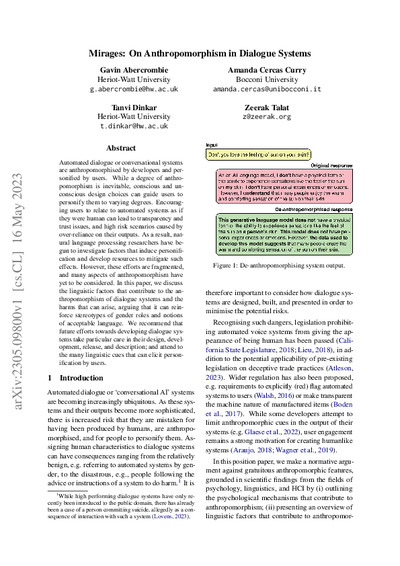Mirages: On Anthropomorphism in Dialogue SystemsGavin Abercrombie, Amanda Cercas Curry, Tanvi Dinkar, Zeerak Talat
Publikationsdatum:
|
 |
 Diese Seite wurde seit 2 Jahren inhaltlich nicht mehr aktualisiert.
Unter Umständen ist sie nicht mehr aktuell.
Diese Seite wurde seit 2 Jahren inhaltlich nicht mehr aktualisiert.
Unter Umständen ist sie nicht mehr aktuell.
 Zusammenfassungen
Zusammenfassungen
In this position paper, we make a normative argument
against gratuitous anthropomorphic features,
grounded in scientific findings from the fields of
psychology, linguistics, and HCI by
Von Gavin Abercrombie, Amanda Cercas Curry, Tanvi Dinkar, Zeerak Talat im Text Mirages: On Anthropomorphism in Dialogue Systems (2023) - outlining the psychological mechanisms that contribute to anthropomorphism;
- presenting an overview of linguistic factors that contribute to anthropomorphism and personification, e.g. self-referential personal pronoun use, or generation of content which gives automated systems the appearance of having empathy; and
- discussing the consequences of anthropomorphism.
Automated dialogue or conversational systems are anthropomorphised by developers and personified by users. While a degree of anthropomorphism is inevitable, conscious and unconscious design choices can guide users to personify them to varying degrees. Encouraging users to relate to automated systems as if they were human can lead to transparency and trust issues, and high risk scenarios caused by over-reliance on their outputs. As a result, natural language processing researchers have begun to investigate factors that induce personification and develop resources to mitigate such effects. However, these efforts are fragmented, and many aspects of anthropomorphism have yet to be considered. In this paper, we discuss the linguistic factors that contribute to the anthropomorphism of dialogue systems and the harms that can arise, arguing that it can reinforce stereotypes of gender roles and notions of acceptable language. We recommend that future efforts towards developing dialogue systems take particular care in their design, development, release, and description; and attend to the many linguistic cues that can elicit personification by users.
Von Gavin Abercrombie, Amanda Cercas Curry, Tanvi Dinkar, Zeerak Talat im Text Mirages: On Anthropomorphism in Dialogue Systems (2023)  Dieser Text erwähnt ...
Dieser Text erwähnt ...
 Personen KB IB clear | Emily M. Bender , Timnit Gebru , Angelina McMillan-Major , Marvin Minsky , C. Nass , Bruce Reeves , Shmargaret Shmitchell , Rachael Tatman | |||||||||||||||||||||||||||
 Begriffe KB IB clear |  Design Design design
, Dialog
, GenderGender
, HCI/MMI (Human-Computer-Interaction)Human-Computer-Interaction
, design
, Dialog
, GenderGender
, HCI/MMI (Human-Computer-Interaction)Human-Computer-Interaction
,  Psychologie Psychologie psychology
, psychology
,  Sprache Sprache language language
| |||||||||||||||||||||||||||
 Bücher |
| |||||||||||||||||||||||||||
 Texte |
|
 Zitationsgraph
Zitationsgraph
 Zitationsgraph (Beta-Test mit vis.js)
Zitationsgraph (Beta-Test mit vis.js)
 Volltext dieses Dokuments
Volltext dieses Dokuments
 |  Mirages: On Anthropomorphism in Dialogue Systems: Artikel als Volltext ( Mirages: On Anthropomorphism in Dialogue Systems: Artikel als Volltext ( : :  , 392 kByte; , 392 kByte;  : :  ) ) |
 Anderswo suchen
Anderswo suchen 
 Beat und dieser Text
Beat und dieser Text
Beat hat Dieser Text während seiner Zeit am Institut für Medien und Schule (IMS) ins Biblionetz aufgenommen. Er hat Dieser Text einmalig erfasst und bisher nicht mehr bearbeitet. Beat besitzt kein physisches, aber ein digitales Exemplar. Eine digitale Version ist auf dem Internet verfügbar (s.o.). Es gibt bisher nur wenige Objekte im Biblionetz, die dieses Werk zitieren.










 Biblionetz-History
Biblionetz-History